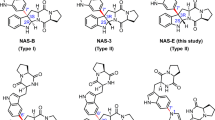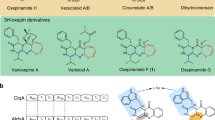Abstract
The catalytic versatility of cytochrome P450 monooxygenases is remarkable. Here, we present mechanistic and structural characterizations of TleB from Streptomyces blastmyceticus and its homolog HinD from Streptoalloteichus hindustanus, which catalyze unusual intramolecular C–N bond formation to generate indolactam V from the dipeptide N-methylvalyl-tryptophanol. In vitro analyses demonstrated that both P450s exhibit promiscuous substrate specificity, and modification of the N13-methyl group resulted in the formation of indole-fused 6/5/6 tricyclic products. Furthermore, X-ray crystal structures in complex with substrates and structure-based mutagenesis revealed the intimate structural details of the enzyme reactions. We propose that the generation of a diradical species is critical for the indolactam formation, and that the intramolecular C(sp2)–H amination is initiated by the abstraction of the N1 indole hydrogen. After indole radical repositioning and subsequent removal of the N13 hydrogen, the coupling of the properly-folded diradical leads to the formation of the C4–N13 bond of indolactam.
This is a preview of subscription content, access via your institution
Access options
Access Nature and 54 other Nature Portfolio journals
Get Nature+, our best-value online-access subscription
$29.99 / 30 days
cancel any time
Subscribe to this journal
Receive 12 print issues and online access
$259.00 per year
only $21.58 per issue
Buy this article
- Purchase on Springer Link
- Instant access to full article PDF
Prices may be subject to local taxes which are calculated during checkout






Similar content being viewed by others
References
Davies, H. M. L., Du Bois, J. & Yu, J. Q. C–H functionalization in organic synthesis. Chem. Soc. Rev. 40, 1855–1856 (2011).
Gutekunst, W. R. & Baran, P. S. C–H functionalization logic in total synthesis. Chem. Soc. Rev. 40, 1976–1991 (2011).
Yamaguchi, J., Yamaguchi, A. D. & Itami, K. C–H bond functionalization: emerging synthetic tools for natural products and pharmaceuticals. Angew. Chem. Int. Ed. 51, 8960–9009 (2012).
Hartwig, J. F. Evolution of C–H bond functionalization from methane to methodology. J. Am. Chem. Soc. 138, 2–24 (2016).
Liao, K. et al. Design of catalysts for site-selective and enantioselective functionalization of non-activated primary C–H bonds. Nat. Chem. 10, 1048–1055 (2018).
Liu, Y. J. et al. Overcoming the limitation of directed C–H functionalization of heterocycles. Nature 515, 389–393 (2014).
Poulos, T. L. Heme enzyme structure and function. Chem. Rev. 114, 3919–3962 (2014).
Rudolf, J. D., Chang, C. Y., Ma, M. & Shen, B. Cytochromes P450 for natural product biosynthesis in Streptomyces: sequence, structure, and function. Nat. Prod. Rep. 34, 1141–1172 (2017).
Guengerich, F. P. & Yoshimoto, F. K. Formation and cleavage of C–C bonds by enzymatic oxidation-reduction reactions. Chem. Rev. 118, 6573–6655 (2018).
Zhang, X. W. & Li, S. Y. Expansion of chemical space for natural products by uncommon P450 reactions. Nat. Prod. Rep. 34, 1061–1089 (2017).
Podust, L. M. & Sherman, D. H. Diversity of P450 enzymes in the biosynthesis of natural products. Nat. Prod. Rep. 29, 1251–1266 (2012).
Tang, M. et al. Oxidative cyclization in natural product biosynthesis. Chem. Rev. 117, 5226–5333 (2017).
Hartwig, J. F. Carbon-heteroatom bond formation catalysed by organometallic complexes. Nature 455, 314–322 (2008).
Park, Y., Kim, Y. & Chang, S. Transition metal-catalyzed C–H amination: scope, mechanism, and applications. Chem. Rev. 117, 9247–9301 (2017).
Barry, S. M. et al. Cytochrome P450-catalyzed l-tryptophan nitration in thaxtomin biosynthesis. Nat. Chem. Biol. 8, 814–816 (2012).
Lin, H. C. et al. P450-mediated coupling of indole fragments to forge communesin and unnatural isomers. J. Am. Chem. Soc. 138, 4002–4005 (2016).
Irie, K. et al. The Epstein–Barr virus early antigen inducing indole alkaloids, (−)-indolactam V and its related compounds, produced by actinomycetes. Agric. Biol. Chem. 49, 1269–1274 (1984).
Chen, S. et al. Small molecule that directs differentiation of human ESCs into the pancreatic lineage. Nat. Chem. Biol. 5, 258–265 (2009).
Lim, H. J., Gallucci, J. C. & Rajanbabu, T. V. Annulzated diketopiperazines from dipeptides or Schollkopf reagents via tandem cyclization-intramolecular N-arylation. Org. Lett. 12, 2162–2165 (2010).
Nakamura, H., Yasui, K., Kanda, Y. & Baran, P. S. 11-Step total synthesis of teleocidins B-1–B-4. J. Am. Chem. Soc. 141, 1494–1497 (2019).
Edwards, D. J. & Gerwick, W. H. Lyngbyatoxin biosynthesis: sequence of biosynthetic gene cluster and identification of novel aromatic prenyltransferase. J. Am. Chem. Soc. 126, 11432–11433 (2004).
Read, J. A. & Walsh, C. T. The lyngbyatoxin biosynthetic assembly line: chain release by four-electron reduction of a dipeptidyl thioester to the corresponding alcohol. J. Am. Chem. Soc. 129, 15762–15763 (2007).
Huynh, M. U. et al. Enzymatic production of (−)-indolactam V by ltxB, a cytochrome P450 monooxynase. J. Nat. Prod. 73, 71–74 (2010).
Awakawa, T. et al. A methyltransferase initiates terpene cyclization in teleocidin B biosynthesis. J. Am. Chem. Soc. 136, 9910–9913 (2014).
Abe, I. Biosynthesis studies on teleocidins in Streptomyces. J. Antibiot. 71, 763–768 (2018).
Mori, T. et al. Manipulation of prenylation reactions by structure-based engineering of bacterial indolactam prenyltransferases. Nat. Commun. 7, 10849 (2016).
Walsh, C. T. Biological matching of chemical reactivity: pairing indole nucleophilicity with electrophilic isoprenoids. ACS Chem. Biol. 9, 2718–2728 (2014).
lrie, K. et al. Synthesis of 6-substituted indolactams by microbial conversion. Tetrahedron 51, 6255–6266 (1995).
Bachmann, B. O. & Ravel, J. In silico prediction of microbial secondary metabolic pathways from DNA sequence data. Methods Enzymol. 458, 181–217 (2009).
Tummino, P. J. & Copeland, R. A. Residence time of receptor–ligand complexes and its effect on biological function. Biochemistry 47, 5481–5492 (2008).
Quesenberry, M. S. & Lee, Y. C. A rapid formaldehyde assay using purpald reagent: application under periodation conditions. Anal. Biochem. 234, 50–55 (1996).
Parisi, G. et al. Substrate-induced conformational change in cytochrome P450 OleP. FASEB J. 33, 1787–1800 (2018).
Takahashi, S. et al. Structure-function analyses of cytochrome P450revI involved in reveromycin A biosynthesis and evaluation of the biological activity of its substrate, reveromycin T. J. Biol. Chem. 289, 32446–32458 (2014).
Li, Q., Chen, Y., Zhang, G. & Zhang, H. Structural analysis of SgvP involved in carbon-sulfur bond formation during griseoviridin biosynthesis. FEBS Lett. 591, 1295–1304 (2017).
Poulos, T. L. Cytochrome P450 flexibility. Proc. Natl Acad. Sci. USA 100, 13121–13122 (2003).
Skopalík, J., Anzenbacher, P. & Otyepka, M. Flexibility of human cytochromes P450: molecular dynamics reveals differences between CYPs 3A4, 2C9, and 2A6, which correlate with their substrate preferences. J. Phys. Chem. B 112, 8165–8173 (2008).
Sevrioukova, I. F. & Poulos, T. L. Structural basis for regiospecific midazolam oxidation by human cytochrome P450 3A4. Proc. Natl Acad. Sci. USA 114, 486–491 (2017).
Tietz, D. R., Podust, L. M., Sherman, D. H. & Pochapsky, T. C. Solution conformations and dynamics of substrate-bound cytochrome P450 MycG. Biochemistry 56, 2701–2714 (2017).
Davies, H. M. & Manning, J. R. Catalytic C-H functionalization by metal carbenoid and nitrenoid insertion. Nature 451, 417–424 (2008).
Singh, B. K., Polley, A. & Jana, R. Copper(II)-mediated intermolecular C(sp 2)–H amination of benzamides with electron-rich anilines. J. Org. Chem. 81, 4295–4303 (2016).
McIntosh, J. A. et al. Enantioselective intramolecular C–H amination catalyzed by engineered cytochrome P450 enzymes in vitro and in vivo. Angew. Chem. Int. Ed. 52, 9309–9312 (2013).
McIntosh, J. A., Farwell, C. C. & Arnold, F. H. Expanding P450 catalytic reaction space through evolution and engineering. Curr. Opin. Chem. Biol. 19, 126–134 (2014).
Tsutsumi, H. et al. Unprecedented cyclization catalyzed by a cytochrome P450 in benzastatin biosynthesis. J. Am. Chem. Soc. 140, 6631–6639 (2018).
Onaka, H., Asamizu, S., Igarashi, Y., Yoshida, R. & Furumai, T. Cytochrome P450 homolog is responsible for C–N bond formation between aglycone and deoxysugar in the staurosporine biosynthesis of Streptomyces sp. TP-A0274. Biosci. Biotechnol. Biochem. 69, 1753–1759 (2005).
Dodani, S. C. et al. Discovery of a regioselectivity switch in nitrating P450s guided by molecular dynamics simulations and Markov models. Nat. Chem. 8, 419–425 (2016).
Alkhalaf, L. M. et al. Binding of distinct substrate conformations enables hydroxylation of remote sites in thaxtomin D by cytochrome P450 TxtC. J. Am. Chem. Soc. 141, 216–222 (2018).
Barton, D. H. R. et al. Investigations on the biosynthesis of morphine alkaloids. J. Chem. Soc. 0, 2423–2438 (1965).
Johnny Hioe, J., Šakić, D., Vrček, V. & Zipse, H. The stability of nitrogen-centered radicals. Org. Biomol. Chem. 13, 157–169 (2015).
Pace, C. N., Vajdos, F., Fee, L., Grimsley, G. & Gray, T. How to measure and predict the molar absorption coefficient of a protein. Protein Sci. 4, 2411–2423 (1995).
Iizaka, Y., Takeda, R., Senzaki, Y., Fukumoto, A. & Anzai, Y. Cytochrome P450 enzyme RosC catalyzes a multistep oxidation reaction to form the non-active compound 20-carboxylrosamicin. FEMS Microbiol. Lett. 364, fnx110 (2017).
Guengerich, F. P., Wilkey, C. J. & Phan, T. T. N. Human cytochrome P450 enzymes bind drugs and other substrates mainly through conformational-selection modes. J. Biol. Chem. 294, 10928–10941 (2019).
Heredia, V. V., Thomson, J., Nettleton, D. & Sun, S. Glucose-induced conformational changes in glucokinase mediate allosteric regulation: transient kinetic analysis. Biochemistry 45, 7553–7562 (2006).
Risky, L. et al. Oxidative demethylation of algal carbohydrates by cytochrome P450 monooxygenases. Nat. Chem. Biol. 14, 342–344 (2018).
Kabsch, W. XDS. Acta Crystallogr. D 66, 125–132 (2010).
Adams, P. D. et al. PHENIX: a comprehensive Python-based system for macromolecular structure solution. Acta Crystallogr. D 66, 213–221 (2010).
Emsley, P. & Cowtan, K. Coot: model-building tools for molecular graphics. Acta Crystallogr. D 60, 2126–2132 (2004).
Holm, L. & Laakso, L. M. Dali server update. Nucleic Acids Res. 44, W351–W355 (2016).
Tian, W., Chen, C., Lei, X., Zhao, J. & Liang, J. CASTp 3.0: computed atlas of surface topography of proteins. Nucleic Acids Res. 46, W363–W367 (2018).
Schüttelkopf, A. W. & van Aalten, D. M. PRODRG: a tool for high-throughput crystallography of protein–ligand complexes. Acta Crystallogr. D 60, 1355–1363 (2004).
Yukl, E. T., Goblirsch, B. R., Davidson, V. L. & Wilmot, C. M. Crystal structures of CO and NO adducts of MauG in complex with pre-methylamine dehydrogenase: implications for the mechanism of dioxygen activation. Biochemistry 50, 2931–2938 (2011).
Acknowledgements
We thank A. Arisawa (MicroBiopharm Japan) for giving us the plasmids of the P450 redox partner CamA and CamB. We thank T. Eguchi and F. Kudo (Tokyo Institute of Technology) for assistance with the stopped-flow experiments. The synchrotron radiation experiments were performed at the BL-1A, and NW12A of the Photon Factory and at beamline TPS-05A and BL15A1 at NSRRC. This work was supported in part by a Grant-in-Aid for Scientific Research from the Ministry of Education, Culture, Sports, Science and Technology, Japan (JSPS KAKENHI grant nos. JP16H06443, JP17H04763 and JP18K19139), Japan Science and Technology Agency (JST SICORP grant no. JPMJSC1701), Kobayashi International Scholarship Foundation and the Takeda Science Foundation.
Author information
Authors and Affiliations
Contributions
T.M., H.N. and I.A. designed the experiments. F.H., T.M. and M.A. performed in vitro analysis and crystallization experiments. I.M. measured pre-steady-state kinetic values. I.M. and H.N. synthesized substrate analogs. S.H. performed structure determination of enzyme reaction products. F.H., T.M., H.N., T.A. and I.A. analyzed the data. T.M. and I.A. wrote the paper.
Corresponding author
Ethics declarations
Competing interests
The authors declare no competing interests.
Additional information
Publisher’s note Springer Nature remains neutral with regard to jurisdictional claims in published maps and institutional affiliations.
Supplementary information
Supplementary Information
Supplementary Tables 1–6 and Supplementary Figures 1–10.
Supplementary Note
Synthetic procedures
Rights and permissions
About this article
Cite this article
He, F., Mori, T., Morita, I. et al. Molecular basis for the P450-catalyzed C–N bond formation in indolactam biosynthesis. Nat Chem Biol 15, 1206–1213 (2019). https://doi.org/10.1038/s41589-019-0380-9
Received:
Accepted:
Published:
Issue Date:
DOI: https://doi.org/10.1038/s41589-019-0380-9
This article is cited by
-
Regulation of P450 TleB catalytic flow for the synthesis of sulfur-containing indole alkaloids by substrate structure-directed strategy and protein engineering
Science China Chemistry (2023)
-
Enzymatic reactions in teleocidin B biosynthesis
Journal of Natural Medicines (2021)
-
The important role of P450 monooxygenase for the biosynthesis of new benzophenones from Cytospora rhizophorae
Applied Microbiology and Biotechnology (2021)



